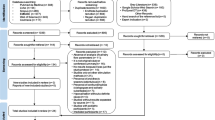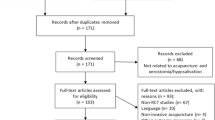Abstract
Sjögren’s syndrome (SS) is a multisystem autoimmune disease characterized by hypofunction of the salivary and lacrimal glands, frequently relieved with symptomatic treatments, such as saliva substitutes, eye lubricants, and cholinergic stimulators. The aim of this pilot randomized placebo-controlled study was to estimate the effects of laser acupuncture on salivary flow rates in patients with severe hyposalivation due to SS. A prospective cohort of 26 female patients affected by SS has been evaluated. The laser therapy equipment used was the Pointer Pulse, emitting light in the red visible spectrum (650 nm), with a power of 5 mW and an irradiation time of 120 s per acupoint, in an area of 3.14 mm2 (fluence = 19.2 J/cm2, power density = 0.16 W/cm2, total dose = 0.6 J). The following acupuncture points were stimulated bilaterally: LI 2 Erjian, ST 5 Daying, ST 6 Jiache, ST 7 Xiaguan, SI 19 Tinggong, and BL 13 Feishu. True laser acupuncture led to a significantly higher amount of saliva production, measured after the end of the protocol (5 weeks), and during the 6-month follow-up period. The results are stable from the end of the protocol until the 3rd month of follow-up; during the last control, a slight but significant decrease in production has also been shown. This preliminary study proposes laser acupuncture as a possible treatment for improving salivary flow rates in patients with SS, but further validation on a larger sample is still necessary.

Similar content being viewed by others
References
Shiboski SC, Shiboski CH, Criswell L et al (2012) American College of Rheumatology classification criteria for Sjögren’s syndrome: a data-driven, expert consensus approach in the Sjögren’s International Collaborative Clinical Alliance cohort. Arthritis Care Res 64:475–487
Mavragani CP, Nezos A, Moutsopoulos HM (2013) New advances in the classification, pathogenesis and treatment of Sjogren’s syndrome. Curr Opin Rheumatol Jul 10
Karu TI, Pyatibrat LV, Moskvin SV, Andreev S, Letokhov VS (2008) Elementary processes in cells after light absorption do not depend on the degree of polarization: implications for the mechanisms of laser phototherapy. Photomed Laser Surg 26:77–82
Whittaker P (2004) Laser acupuncture: past, present and future. Laser Med Sci 19:69–80
Baxter GD, Bleakley C, McDonough S (2008) Clinical effectiveness of laser acupuncture: a systematic review. J Acupunct Meridian Stud 1:65–82
Blom M, Lundeberg T (2000) Long-term follow-up of patients treated with acupuncture for xerostomia and the influence of additional treatment. Oral Dis 6:15–24
List T, Lundeberg T, Lundström I, Lindström F, Ravald N (1998) The effect of acupuncture in the treatment of patients with primary Sjögren’s syndrome. A controlled study. Acta Odontol Scand 56:95–99
Blom M, Kopp S, Lundeberg T (1999) Prognostic value of the pilocarpine test to identify patients who may obtain long-term relief from xerostomia by acupuncture treatment. Arch Otolaryngol Head Neck Surg 125:561–566
Blom M, Lundeberg T, Dawidson I, Angmar-Månsson B (1993) Effects on local blood flux of acupuncture stimulation used to treat xerostomia in patients suffering from Sjögren's syndrome. J Oral Rehabil 20:541–548
Vitali C, Bombardieri S, Jonsson R et al (2002) Classification criteria for Sjogren’s syndrome: a revised version of the European criteria proposed by American European Consensus Group. Ann Rheum Dis 61:554–558
Dawidson I, Angmar-Mânsson B, Blom M, Theodorsson E, Lundeberg T (1999) Sensory stimulation (acupuncture) increases the release of calcitonin gene-related peptide in the saliva of xerostomia sufferers. Neuropeptides 33:244–250
Blom M, Dawidson I, Fernberg JO, Johnson G, Angmar-Månsson B (1996) Acupuncture treatment of patients with radiation-induced xerostomia. Eur J Cancer B Oral Oncol 32B:182–190
Blom M, Dawidson I, Angmar-Månsson B (1992) The effect of acupuncture on salivary flow rates in patients with xerostomia. Oral Surg Oral Med Oral Pathol 73:293–298
Simcock R, Fallowfield L, Monson K et al (2013) ARIX: a randomised trial of acupuncture v oral care sessions in patients with chronic xerostomia following treatment of head and neck cancer. Ann Oncol 24:776–783
Furness S, Bryan G, McMillan R, Birchenough S, Worthington HV (2013) Interventions for the management of dry mouth: non-pharmacological interventions. Cochrane Database Syst Rev 9, CD009603
Wang WC, Vachiramon S, Vachiramon A, Vachiramon T (2004) Treatment of xerostomia in prosthetic patients using local acupuncture points on the face. J Contemp Dent Pract 5:133–138
Johnstone PA, Peng YP, May BC et al (2001) Acupuncture for pilocarpine-resistant xerostomia following radiotherapy for head and neck malignancies. Int J Radiat Oncol Biol Phys 50:353–357
Deng G, Hou BL, Holodny AI, Cassileth BR (2008) Functional magnetic resonance imaging (fMRI) changes and saliva production associated with acupuncture at LI-2 acupuncture point: a randomized controlled study. BMC Complement Alternat Med 8:37–43
Author information
Authors and Affiliations
Corresponding author
Rights and permissions
About this article
Cite this article
Cafaro, A., Arduino, P.G., Gambino, A. et al. Effect of laser acupuncture on salivary flow rate in patients with Sjögren’s syndrome. Lasers Med Sci 30, 1805–1809 (2015). https://doi.org/10.1007/s10103-014-1590-8
Received:
Accepted:
Published:
Issue Date:
DOI: https://doi.org/10.1007/s10103-014-1590-8




